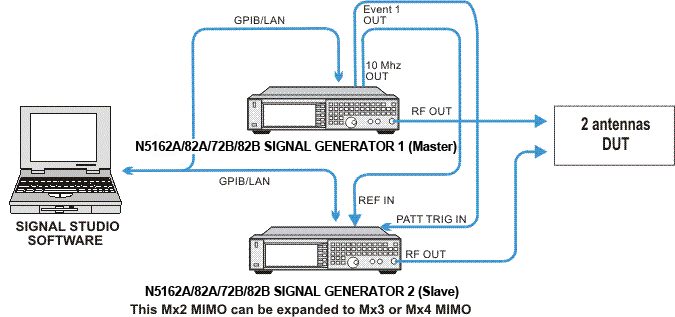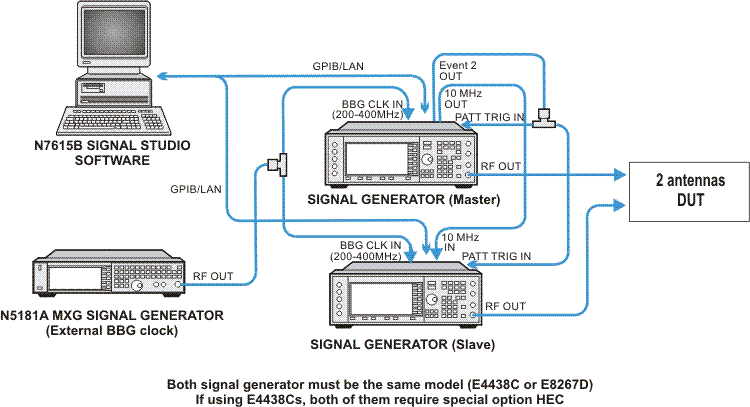
This topic describes the following configurations:

Figure 1. Using X-Series Signal Generators
The figure above shows you how to set up two X-Series signal generators (either N5182A, N5172B, or N5182B) for the Multiple Antennas WiMAX Solution with Baseband Timing Alignment, but without RF Phase Coherence.
If you are using an N5172B or N5182B and one or more N5182A signal generators, you must configure the N5172B or N5182B as the Master. In addition, the N5182A slaves must be at the end of the instrument chain.
The X-Series signal generator provides precise baseband timing alignment as a standard feature, which synchronizes the start of the BBG waveform playback capability of up to 16 signal generators. For the N5182A the playback is synchronized to within a characteristic value of ± 8 ns between the master and the last slave. For the N5172B or N5182B, the playback is synchronized to within a characteristic value of ± 5 ns between the master and the last slave. When working with the Signal Studio for Mobile WiMAX, we only use two MXG/EXG signal generators to simulate the signals on two antennae. This minor amount of delay (± 8 ns or ± 5 ns) can be reduced further to picosecond resolution by adjusting the I/Q Delay. To reduce the delay, check and adjust the BBG signal alignment for each instrument in the system. For more information on adjusting the delay, refer to the section entitled "I/Q Adjustments" in the MXG/EXG X-Series user's guide.
The delay value includes compensation for cables that have less than 1 ns of propagation delay between the EVENT 1 and PAT TRIG connectors. To minimize synchronization delay, the Keysight BNC cable 10502A is the recommended cable for the rear-panel daisy chain connections
The Event 1 connector on the master MXG/EXG rear panel is connected to the Pattern Trigger In connector on the slave MXG/EXG. This ensures that the two baseband generators are precisely synchronized on the start of the waveform playback. Synchronization occurs after the master signal generator sends a one-time event pulse through the Event 1 connector to the slave instrument. Prior to this event, the slave instrument must recognize that it is waiting for this event pulse, which occurs during the system configuration. (Refer to the section entitled "Multiple Baseband Generator Synchronization" in the MXG/EXG X-Series user's guide.) In order to properly send the synchronization pulse, the Dual ARB Player for each instrument must be turned off. The trigger source on the both instruments is automatically set by the software. On the master MXG/EXG, it is set to "Bus" to waiting for a SCPI command trigger through the GPIB or LAN bus. On the slave MXG/EXG, it is set to "External" to receive a trigger through the rear-panel PAT TRIG connector.
When you start Signal Studio for Mobile WiMAX, you must select in the System Configuration Wizard. You will be asked for connection information for the corresponding number of MXG/EXG signal generators. Both instruments must have a valid license for N7615C advanced capability in order to have access to the software features for the multiple antennae. Once you have connected to both MXG/EXG instruments, the software sends SCPI commands to both instruments and automatically completes the system configuration. You can now perform the steps to synchronize the baseband generators of each MXG/EXG. (Refer to the section entitled "Multiple Baseband Generator Synchronization" in the MXG/EXG X-Series user's guide.)
When you generate the waveforms for multiple antennas, the Mobile WiMAX software pre-calculates the waveform packets and applies the effects of specific channels, then loads the composite waveform into each instrument.

Figure 2. Using Two E4438C ESG or E8267D PSG Vector Signal Generators
The figure above shows you how to set up the signal generators (ESG or PSG) for the Multiple Antennae WiMAX Solution with Baseband Timing Alignment, but without RF Phase Coherence.
Two signal generators (with the same model number) are used and the 10 MHz references are connected between them. When using E4438C ESG signal generators, each requires the special option HEC to provide the external baseband generator clock input on the rear panel. An N5181A MXG signal generator is used as an external common clock for the two baseband generators to ensure timing alignment of the baseband signals. The Event 2 connector on the master signal generator is connected to the Pattern Trigger In connector on each of the two signal generators. This ensures that the two baseband generators are triggered simultaneously, eliminating time errors in the waveform output. The synchronization occurs right after downloading the waveforms to the both signal generator. The Signal Studio software will send a SCPI command to the master signal generator to direct it to send a one-time event pulse through the Event 2 connector to itself and the slave signal generator. Then, this pulse signal triggers the two signal generator to playback the waveform simultaneously.
The EVENT 2 signal works as both a Trigger Source and an actual Marker 2 output signal, but in different period of time. Before the waveform playback, EVENT 2 serves as the trigger source. Once waveforms are triggered to playback, EVENT 2 won't work as a trigger source and come back to the Marker 2 output whenever marker 2 is present in the waveform.
When you start the Signal Studio for Mobile WiMAX, you will need to choose the in the System Configuration Wizard. You will be asked for connection information for the corresponding number of instruments. Both instruments must be the same model and both must have a valid license for N7615C Advanced Capability in order to have access to most of the software features for multiple antennas.
When you generate the waveforms for multiple antennas, the Mobile WiMAX software pre-calculates the waveform packets and applies the effects of specific channels, then loads the composite waveform into each instrument and applies it directly to the DUT.